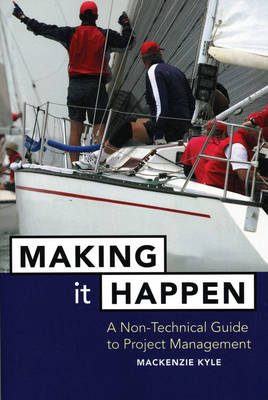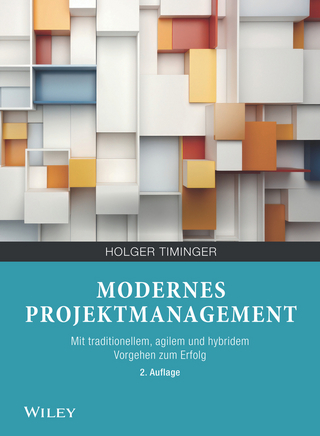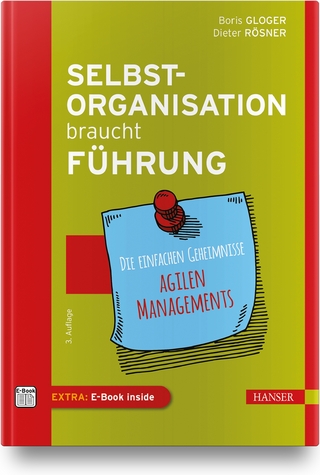
Making It Happen
John Wiley & Sons Inc (Verlag)
978-0-471-64234-3 (ISBN)
Making It Happen: A Non-Technical Guide to ProjectManagement provides a fresh and clear approach to projectmanagement. Written in the form of a novel, it covers the basics ofproject management in a friendly, interesting, and memorable way.
Will Campbell, a reasonably competent middle manager, issuddenly thrust into managing a high-profile project that couldmake or break his career. With no project management experience,and armed only with the guidance of his eccentric menror, Martha,Will learns the hard way. As Will navigates the rough seas ofcompany politics, treacherous competition, and a project swirlingout of control, he narrowly evades many pitfalls, and masters someindispensable project management tools along the way.
Against the backdrop of this personal drama, a simple, rationalapproach to project management unfolds. Will's ability to graspthese principles is the key to his survival, and could be the keyto yours. Making It Happen enables the reader to transformrisky, real-life situations into success.
* Provides a simple, non-technical approach, useful to anybusiness person involved in teams or managing projects
* Offers practical tools and principles that will make anyproject a success: from office moves to product roll-outs, systemsimplementations to training program delivery, and everything inbetween
* Boxes, definitions, and charts highlight key points andpractical project management tips.
Mackenzie Kyle is the Principle of the Beringer Group and an associate at Manageering, a firm specializing in project management consulting and training. He has spent the last 15 years working on a variety of project management related assignments at organizations in Canada, the United States, Australia, New Zealand, and Asia.
Preface xiii
Acknowledgments xvi
Unit 1 the Legal Landscape 1
Chapter 1
Introduction to Hiring and
Supervising Employees 3
Chapter Objectives 3
HRM in Action 4
Overview of What’s to Come 4
Tales from the Field 5
Increased Competition 5
The Changing Labor Market 8
Hospitality Industry Jobs 8
A Note About Ethics 9
Ethical Dilemma 10
Workforce Demographics Will Change 10
Nontraditional Workers 12
Increased Demand 12
Industry Remains Strong 14
Motivations, Needs, and Expectations 15
Training and Motivation 15
Hands-on HRM 19
Chapter 2
The Hospitality Manager’s Legal Challenges 21
Chapter Objectives 21
HRM in Action 22
Employment Law and the Equal Employment Opportunity Commission 22
Tales from the Field 25
Illegal Discrimination 25
Bona Fide Occupational Qualification 26
Ethical Dilemma 27
The Hooters Restaurant Chain 27
Sexual Harassment 28
Managers Must Establish Guidelines and Policies 29
State and Local Employment Laws 30
Affirmative Action Plans 30
The Americans with Disabilities Act 31
Disability Defined 32
Reasonable Accommodation 33
Avoiding Illegal Questions and Practices Under the ADA 33
Age Discrimination in Employment 34
Equal Pay Act 34
Immigration Reform and Control Act 35
Hands-on HRM 39
Chapter 3
Wage and Hour Laws Affecting Salaried, Hourly, and Tipped Employees 43
Chapter Objectives 43
HRM in Action 44
A Brief History 44
Tales from the Field 45
Tip Credits and Tip Pools 47
Regular Tips 50
Tip Retention 50
Slow Shifts 50
Advance Notice 50
Tip Pools 51
Ethical Dilemma 52
Overtime 52
Changes in Overtime Law 53
The New Rules 55
Executive (Managerial) Exemption 55
Administrative Exemption 56
Professional Exemption 56
Labor Costs, Profits, and Employee Morale 57
Hands-on HRM 61
Chapter 4
Common Law, Negligent Hiring, And Employee Rights 65
Chapter Objectives 65
HRM in Action 66
Common Law and Its Impact on the Workplace 66
Tales from the Field 67
McDonald’s Coffee Too Hot? 68
Employee Rights Under Common Law 69
Wrongful Discharge 69
Ethical Dilemma 71
Constructive Discharge 71
False Imprisonment, Defamation, and Invasion of Privacy 72
Defamation of Character 72
Negligent Hiring and Negligent Retention 74
Hands-on HRM 78
Chapter 5
Working with Unions 81
Chapter Objectives 81
HRM in Action 82
States and Metro Areas with a Large Union Concentration 82
Tales from the Field 83
The National Labor Relations Act 83
The Taft-Hartley Act and Right-to-Work Laws 84
Local Unions 85
Ethical Dilemma 86
National Unions 87
Multiunion Associations 87
Why Employees Join Unions 88
The Union Organization Process 89
Employers May Not Retaliate 89
The Union Contract 89
Management Challenges When Working with Unions 90
Creating a Positive Work Environment 91
Hands-on HRM 94
Unit 2 the Employee Selection Process 97
Chapter 6
Job Descriptions and Job Specifications 99
Chapter Objectives 99
HRM in Action 99
The Employee Selection Process 100
Job Descriptions 100
Tales from the Field 101
Essential Elements 101
Performance Standards 104
Ethical Dilemma 105
Contents vii
Essentials for Success 106
Job Specifications 107
One Size Does Not Fit All 111
Hands-on HRM 114
Chapter 7
The Employee Handbook 117
Chapter Objectives 117
HRM in Action 117
Rationale for Employee Handbooks 118
Tales from the Field 119
Employee Handbooks Are Common in Large Operations 119
Employees Must Sign for It 119
A Well-Crafted Employee Handbook 120
Write It Yourself but Have an Attorney Review It 120
Ethical Dilemma 122
Be Clear, Concise, and Consistent 122
Setting the Proper Tone in the Introduction 122
Legal Issues and Disclaimers 123
Probationary Period, Trial Period, or Training Period? 125
What to Include in the Employee Handbook 125
Hands-on HRM 130
Chapter 8
Advertising and Recruiting 133
Chapter Objectives 133
HRM in Action 133
The Labor Market and the Labor Pool
134
The Internet Expands the Labor Market
134
Tales from the Field 135
Smaller Operations Have Some Advantages 135
Employee Turnover 136
Tales from the Field 137
Identifying Potential Job Applicants 139
Employee Referrals 139
Paying a Referral Bonus 140
Recruiting Is Marketing 140
Walk-In Applicants 141
Ethical Dilemma 142
Walk-In Applicants Should Be Welcome 142
Advertising for Job Applicants 143
Help-Wanted Ads Have Some Limitations 143
Diversity—The New Workforce 145
Targeting the New Workforce 147
Hot Buttons 148
Language Solutions for Managers and Supervisors 148
Hands-on HRM 152
Chapter 9
Applications, Interviews, and Background Checks 155
Chapter Objectives 155
HRM in Action 156
The Job Application 156
Tales from the Field 157
A Fact-Finding Form 157
Personal Data 157
Employment Status 160
Education and Skills 160
Work History 160
References 160
Tales from the Field 161
Signature Line 161
Analyzing Application Forms 163
Preparing for the Job Interview 164
The Job Interview 165
Process Is a Two-Way Street 165
Conducting the Interview 166
The Applicant Should Do Most of the Talking 167
Don’t Oversell the Position 167
Check for Any “Knockout Factors” 167
Closed-Ended and Open-Ended Questions 168
Situational and Behavioral Questions 169
How Long Should the Interview Last?
170
Questions to Avoid 170
The Job Offer 172
The Act of the Employee 172
Ethical Dilemma 173
Background Checks 174
Why Conduct Background Checks? 174
Obtaining the Applicant’s Permission 176
Many Employees Have Skeletons in Their Closets 177
Who Performs Background Checks? 178
Who Should Be Checked? 178
Reference Checks 180
Should I Give References on a Previous Employee? 180
Hands-on HRM 185
Unit 3 Orientation And Training 189
Chapter 10
New-employee Orientation 191
Chapter Objectives 191
HRM in Action 191
Starting off on the Right Foot 192
The Need for New-Employee Orientation 192
Tales from the Field 193
Benefits of Orientation 193
The Benefits to the Company Overall
194
The Benefits to the Supervisor and to Management 194
The Benefits to the Employee 194
Orientation Programs 195
Ethical Dilemma 198
Make New-Employee Orientation Fun 198
Avoid Common Mistakes 199
Work with a Checklist 199
Before the New Employee Arrives 200
First Day on the Job 200
During the First Week 200
Tales from the Field 201
Hands-on HRM 204
Chapter 11
Training to Performance Standards 207
Chapter Objectives 207
HRM in Action 208
Training Now and Development Later 208
Benefits of Training and Development 209
Tales from the Field 211
Performance Standards and Needs Assessment 211
Understanding Performance Management 212
Ethical Dilemma 213
Importance of Performance Standards 213
Contents ix
Performance Standards and Training 214
How to Set Performance Standards 214
Determining Training Needs 216
Approaches to Needs Assessment 218
Determining Training Objectives 218
Learning Principles 219
Considerations When Selecting Training Techniques 220
Training Methods 221
Problems Associated with OJT 222
Problems with Job Rotation and Cross-training 223
Train the Trainer Programs 223
Off-the-Job Training Methods 224
Increased Use of Technology 224
Other Training Methods 226
Internships 226
Role Playing 226
Case Study 226
Self-Study 227
Evaluating Training 227
Hands-on HRM 231
Unit 4 Communication And Motivation 235
Chapter 12
Performance Appraisals That Work 237
Chapter Objectives 237
HRM in Action 238
Everyone Benefits from Effective Performance Appraisals 238
Informal and Formal Appraisals 239
Common Performance Appraisal Problems 240
Tales from the Field 241
Understanding Rater Biases 242
The Halo-or-Horns Effect 242
The Error of Central Tendency 243
The Leniency and Strictness Biases 243
Cross-Cultural Biases 243
Personal Prejudice 243
The Recency Effect 244
Similar-to-Me Bias 244
Overcoming Obstacles and Reducing Errors 244
Performance Appraisal Methods 244
Ethical Dilemma 245
Rating Scales 245
Checklists 247
Forced Choice Method 248
Critical Incidents Method 249
Behaviorally Anchored Rating Scales 250
Self-Appraisals 252
360-Degree Performance Appraisal 252
Evaluation Interviews and Employee Counseling 253
Legal Constraints in Performance Appraisals 254
Hands-on HRM 257
Chapter 13
Effective Communication And Feedback 261
Chapter Objectives 261
HRM in Action 262
The Communication Process 262
An Example from Marriott 262
Tales from the Field 263
Which Communication Method Is Best? 263
The Employee Grapevine 264
Downward and Upward Communication 265
Tales from the Field 267
Verbal and Written Communication 267
Ethical Dilemma 269
The Information Superhighway 269
Corporate Web-Surfing Policies 271
Common Obstacles to Effective Communication 271
Cultural Differences 272
Differences in Background 272
Prejudices and Perceptions 273
Assumptions and Expectations 274
Emotions 274
Overcoming Barriers to Effective Communication 275
Active and Passive Listening 275
Providing Effective Feedback 276
The Role of Positive Feedback 276
The Role of Negative Feedback 277
Guidelines for Providing Feedback That Works 277
Hands-on HRM 281
Chapter 14
Employee Discipline 285
Chapter Objectives 285
HRM in Action 286
Causes for Discipline 286
Cause 1: Rules and Procedures Are Vaguely Written, Misunderstood, and Ignored 286
Tales from the Field 287
How to Ensure Acceptance and Compliance 288
Cause 2: Employees Lack Sufficient Abilities, Knowledge, Skills, or Aptitude 289
Cause 3: Employees Have Personality and Motivational Problems 290
Cause 4: Troublesome Environmental Factors 291
Preventive and Corrective Discipline 291
Oral or Verbal Warning 293
Written Warning 293
Suspension 293
Ethical Dilemma 294
Termination 294
Six Discipline Don’ts 295
Don’t Regard Discipline as Punishment
295
Don’t Make Discipline a Me Against You Confrontation 296
Don’t Do Too Little Too Late 296
Don’t Create New Rules “on the Fly” 297
Don’t Take a Nonprogressive Approach Unless Unavoidable 297
Don’t Ignore the Root Causes 297
Five Discipline Dos 297
Do Thoroughly Investigate 298
Do Confront the Employee 298
Do Get a Commitment 300
Do Use Progressive Discipline When Possible 300
Do Follow Up on Employee Discipline
300
When to Terminate an Employee 301
Legal Implications When Terminating an Employee 302
Guidelines for Terminating an Employee
303
Hands-on HRM 306
Contents xi
Chapter 15
Employee Motivation Through Quality Leadership 311
Chapter Objectives 311
HRM in Action 312
Relationship between Leadership and Motivation 312
Motivational Theories 313
Early Theories of Motivation 313
The Traditional Model 313
Tales from the Field 314
The Human Relations Model 314
The Human Resources Model 315
Later Theories of Motivation 316
Maslow’s Hierarchy of Needs 316
Herzberg’s Motivation-Hygiene Theory 317
Modern Approaches to Motivation 318
The Expectancy Approach 319
Implications for Hospitality Managers 319
Ethical Dilemma 320
Making the Reward System Cost-Effective 321
The Equity Theory 322
Putting Motivational Practices to Work 322
Employees Seek Praise 322
Employees Seek Convenience 323
Employees Seek Fun 323
Employees Seek Money 323
Employees Seek Importance 324
Employees Seek Success 324
Employees Seek Advancement 325
What Is Leadership? 325
Early Leadership Theories 325
Modern Views and Charismatic Leadership 327
Formal and Informal Authority 327
Deciding Whom to Promote 328
Technical Skills 328
Human Relations Skills 328
Conceptual Skills 328
What’s Your Style? 329
Which Style Is Best? 329
Hands-on HRM 334
Index 339
| Erscheint lt. Verlag | 18.11.1999 |
|---|---|
| Verlagsort | New York |
| Sprache | englisch |
| Maße | 151 x 228 mm |
| Gewicht | 340 g |
| Themenwelt | Wirtschaft ► Betriebswirtschaft / Management ► Projektmanagement |
| ISBN-10 | 0-471-64234-7 / 0471642347 |
| ISBN-13 | 978-0-471-64234-3 / 9780471642343 |
| Zustand | Neuware |
| Haben Sie eine Frage zum Produkt? |
aus dem Bereich


